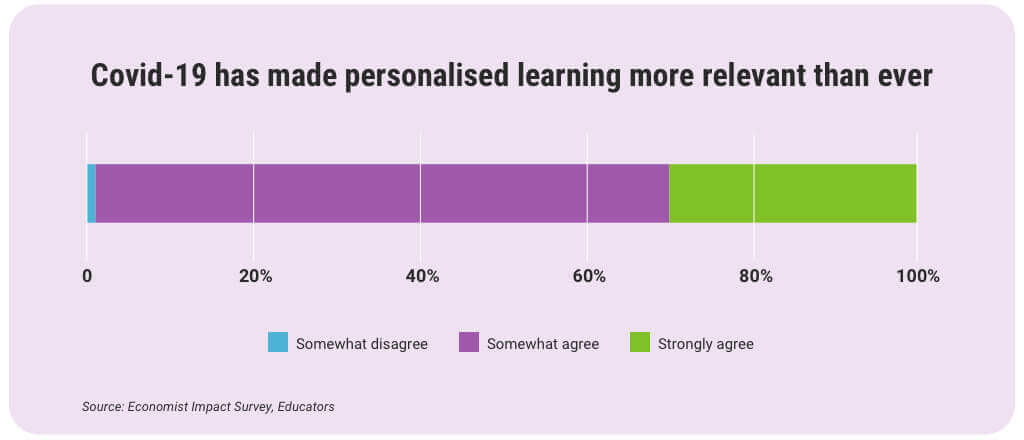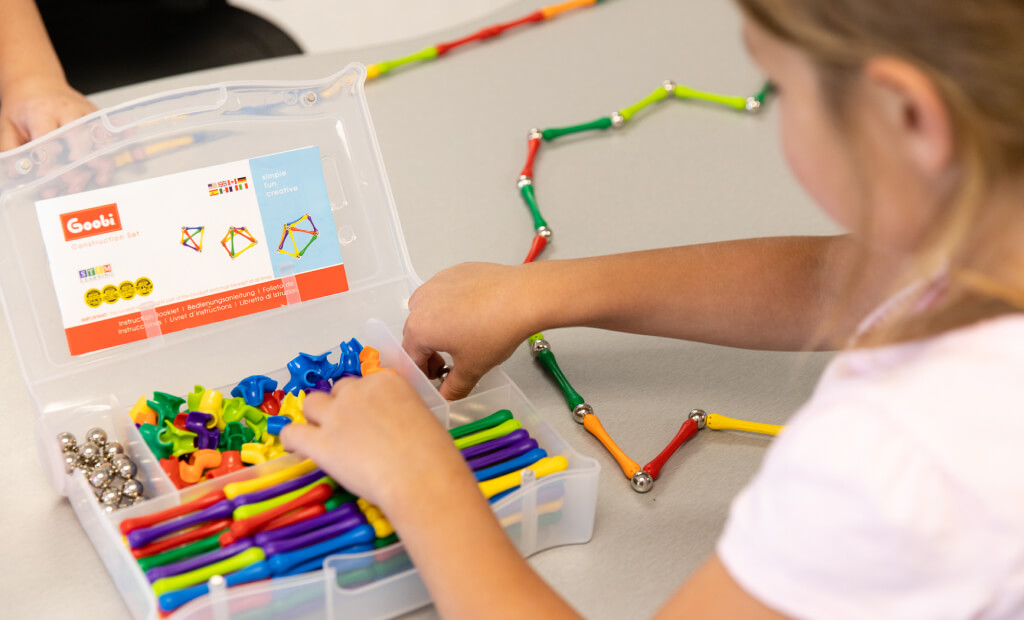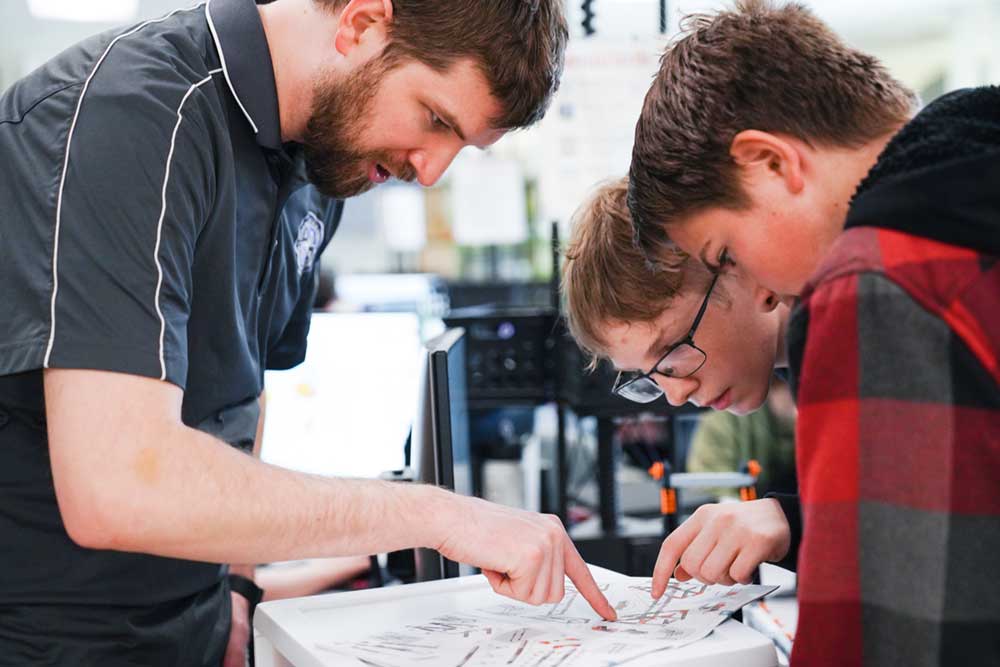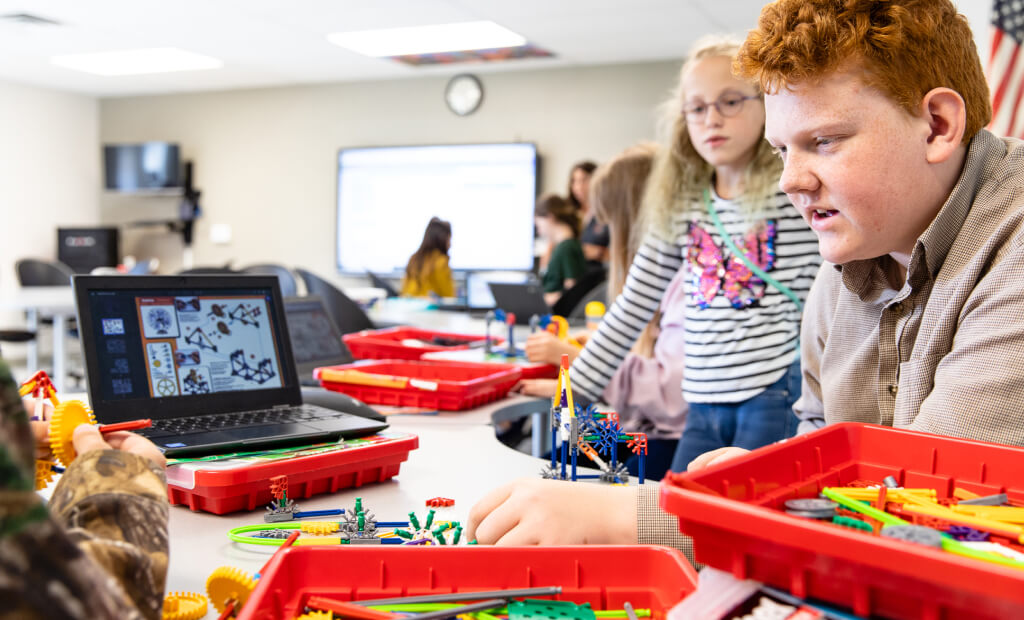Your Guide To Personalized Learning: Examples, Benefits & More
Every student is different, with varying experiences, interests, and learning needs. That means standardized testing and set lesson plans can leave some students behind. Could tailoring learning to students’ unique interests and background serve them better by connecting with and motivating them? That’s the approach championed by personalized learning.
Personalized learning attempts to make learning more personally relevant to students and keep them engaged. As student populations have grown more diverse, schools are faced with a wider range of student experiences, academic interests, and language needs.
At the same time, In our post-pandemic environment, digital technology is now widely recognized as a powerful and necessary educational tool — is it enough to help make personalized learning available to more students?
In this article we review the approach of personalized learning, and take a closer look at what it entails, benefits and challenges.
What Is Personalized Learning?
First, let’s acknowledge there are some disagreements about how to define personalized learning. The term “personalized learning” can be used to describe large-scale approaches, such as how to structure classes throughout a district, or to refer to more specific materials such as technology tools or software programs. Personalized learning is also often conflated with “student-centered learning” — which has its own set of associations and meanings.
For our purposes, we’re defining personalized learning as an educational approach that seeks to tailor instruction and assessment to each student’s unique needs, skills, interests, backgrounds, and preferences. The structure of a course or lesson under personalized learning is developed through a collaborative approach between students and instructors, with each student following a learning plan that’s based on what they know and how they learn best.
We’re basing our definition off of how the US Department of Education defines personalized learning as
“instruction in which the pace of learning and the instructional approach are optimized for the needs of each learner. Learning objectives, instructional approaches, and instructional content (and its sequencing) all may vary based on learner needs. In addition, learning activities are meaningful and relevant to learners, driven by their interests, and often self-initiated.”
Though the use of technology to support a personalized program is relatively new, the concept itself can trace its roots to earlier education traditions.
- Engineering models of personalized learning first appeared in the 1950s, when psychologist B.F. Skinner experimented with “teaching machines” that were intended to allow students the ability to answer questions and receive feedback at their own pace.
- At the turn of the 20th century, Philosopher John Dewey advocated for a more progressive model of education, in which students would be active problem solvers instead of passive listeners during lectures. It’s a model utilized today in programs that emphasize project-based learning.
- Until his death in 1934, Soviet psychologist and social constructivist, Lev Vygotsky continually conceptualized the Zone of Proximal Development (ZPD), which refers to an area between what a learner can already do independently and what is beyond their reach. Students are able to learn and achieve within this zone through the guidance and support of a more knowledgeable person, such as a teacher, peer or a more capable adult.
The ZPD, in particular, serves as a helpful perspective for understanding the personalized learning approach. It refers to the range of tasks or skills that a learner can’t perform on their own but can accomplish with assistance or support. In a similar way, personalized learning centers on connecting a learner’s previous knowledge, experiences, and abilities with materials and support that enables them to leverage that understanding with new information.
By identifying a student’s ZPD, instructors can provide appropriate levels of support and guidance to help them progress and eventually master new skills or concepts. The use of technology can further expand students’ ZPD by creating a space where the instructor doesn’t have to assess every need of every student to allocate resources. Instead, engaged students that want to achieve their own goals will gravitate toward the resources that meet them “where they are” — which also frees up the instructor/facilitator to spend more time with issues that require more direction.
How Personalized Learning Works
While personalized learning approaches will vary greatly, in general each student in a personalized learning program will work with an instructor to develop a learning plan based on the course content and learning goals; the students’ existing skills, knowledge, and interests; and the approaches that the instructor(s) believes to best allow for discovery and understanding of the content. It’s the opposite of the “one size fits all” approach used in most traditional forms of instruction.
Personalized learning lesson plans involve several core elements, including data-driven decisions, flexible content, and student reflection and ownership:
- Assess and profile: Personalized learning starts with a comprehensive assessment of each student’s strengths, weaknesses, background and interests. This profiling helps to create a clear understanding of the student’s current knowledge and skills, as well as their learning preferences.
- Determine goals: Instructors make sure that proposed learning plans or project-based learning assignments will match up with established academic standards. Throughout the course, they will check-in with students to see if they’re demonstrating expected skills and knowledge needed to achieve their learning goals.
- Review data: Technology plays a crucial role in personalized learning by collecting and analyzing data on each student’s progress and performance. Instructors will make use of data-driven insights to evaluate each student’s strengths, needs and preferences. Data should be continuously collected for authentic assessment of a student’s growth, to identify areas of improvement and to help instructors make informed decisions on if they need to adjust the learning path or provide targeted support.
- Design learning paths: Based on their assessment, goals and data the instructors will design unique learning paths for each student. These paths outline the specific content, activities and pace that align with the student’s capabilities and learning goals. Students may progress through the material at their own speed and have the flexibility to delve deeper into topics of interest or spend more time on challenging concepts.
- Foster student agency and ownership: In personalized learning, students are encouraged to take a more active role in their learning journey. Instructors will work with students to set learning goals, choose activities and discuss their progress. This autonomy helps to foster a sense of responsibility and motivation in students.
- Set long term and short term student goals: Students may learn some skills at different paces, so they will also work with instructors to set both short-term and long-term goals. All goals should align with course standards to keep students on track to meet state and national standards.
- Create collaborative learning groups: Personalized learning is not intended to happen in isolation, but is meant to be highly collaborative. Students will work together on group projects, which helps teach valuable communication, cooperation and leadership skills.
Should collaborative learning be in homogeneous or heterogeneous groups?
Studies have found that while many students perform well in either group, low-performing students had higher learning outcomes when they were in heterogeneous groups. Furthermore, students of all competence types had better attitudes toward group work while in heterogeneous groups. While some homogeneous groups can improve academic performance, a review of studies shows that heterogeneous environments can benefit students’ learning and socialization, preparing them for positive classroom interaction and socialization within an increasingly diverse society.
- Prioritize flexible instruction: As students progress through their individual learning paths, instructors will need to continuously assess and refine the personalized learning approach. Instructors should be able to adapt their teaching methods and strategies to suit the diverse needs of their students. This may include adjusting to one-on-one instruction, small group activities or collaborative projects.
- Make iterative improvement: Lessons learned from one student’s experience can inform and improve the learning paths for future students. The more that teachers can provide ongoing guidance and constructive feedback to students, the better they can assist students to stay on track and make improvements as needed.
Finally, it’s important to understand that personalized learning doesn’t end at the classroom door. Parents and the broader community also play a role in personalized learning and should be invited to support and reinforce the learning process outside of the classroom.
The Benefits of Personalized Learning
It’s common in traditional methods of instruction — especially in larger classes — to “teach to the middle” and focus the lessons toward the average students. This approach not only risks leaving slower learners behind, it can frustrate and bore faster learners, who may also disengage. The personalized learning experience is different for each student, resulting in the following benefits:
- Improved retention and understanding: When students have the opportunity to learn at a pace that suits them, they are more likely to retain information and develop a deeper understanding of subject matter.
- Increased student engagement: By incorporating students’ interests and preferences into the learning process, personalized learning can boost student engagement. When students are more engaged, they are more likely to be motivated and actively participate in their education.
- Empowerment and self-direction: With personalized learning, students have more control over their learning journey. They can set goals, make choices and take ownership of their education, promoting a sense of empowerment, self-advocacy and self-direction. As partners in their own learning they’re encouraged to speak up about what interests them.
- Greater teacher-student interaction: Personalized learning allows instructors to spend more time working directly with students, which can lead to stronger relationships, a deeper understanding of individual learning needs and more targeted support.
- Enhanced critical thinking and other soft skills: Personalized learning often involves more active and independent learning experiences, which can foster important skills such as critical thinking, problem-solving and decision-making. Collaboration also allows students the opportunity to develop and practice soft skills like empathy, creativity and communication.
- More efficient learning paths: Personalized learning, when properly supported by data and technology, can help instructors save time on administrative tasks so they can focus more on supporting students. Data-driven decision making enables instructors to make informed decisions and tailor instruction more effectively.
- Support inclusivity and diversity initiatives: Personalized learning acknowledges and embraces the diverse needs and backgrounds of students, promoting a more inclusive and equitable educational environment.
The Challenges of Personalized Learning
Though its foundations are sound and its benefits laudable, there are some concerns regarding the efficacy of personalized learning. Largely, the fear is that when personalized learning is over-hyped and not executed carefully, there can be faulty assumptions that don’t end up matching the actual results. When considering a personalized learning program, it’s important to keep the following challenges in mind:
- Is the solution scalable and sustainable? While personalized learning may work well in smaller pilot programs, scaling it up to larger educational systems or out to the entire district may not be feasible. Schools need to ensure that their programs are sustainable and can be consistently implemented; otherwise, they’re of limited value.
- Is technology being used to assist learning, or is it being used in place of learning? One of the biggest concerns over the push toward personalized learning in the late 2010s was that Big Tech companies would employ digital technology as a cure-all solution that would undermine communal values, accelerate privatization and act as big-data siphons. Technology has to be employed as a thoughtful tool; otherwise, over-reliance on tech may lead to isolation of some students.
- Do schools and districts have access to necessary resources? Implementing personalized learning often requires significant investments in technology, learning resources and teacher training. Not all educational institutions have the financial resources to fully support personalized learning initiatives and just investing in new technology systems won’t guarantee success.
- Is there buy-in from instructors, administration and the community? Personalized learning can come with resistance from various stakeholders, including teachers, administrators, parents and even students. Schools — especially those that operate within traditional district structures — might struggle as their new personalized instruction conflicts with long-standing district or state policies.
- Do instructors and facilitators have access to sufficient professional development? Instructors need to be well-trained to implement personalized learning effectively. Aside from their subject matter knowledge, they must be proficient in using technology, data analysis, and how to employ differentiated instructional strategies. Instructors will also likely need inclusion training and experience in how to support students with executive functioning difficulties.
- Are there other programs to support and supplement personalized learning programs? Personalization isn’t a cure-all approach. It cannot stand in for special education and should not replace an Individualized Education Plan, a 504 plan, or academic intervention programs. When employed along with personalized learning, these programs give at-risk and struggling students better support and allow them to find paths toward owning their learning.
- Is there an infrastructure in place to record, access, and use data? Gathering and interpreting data on individual student progress is essential for success in personalized learning, but it can be a complex process. Instructors might not know how to track competencies or analyze student data, especially when dealing with large and diverse student populations. Educators need to ensure they’re using data effectively to make informed decisions about each student’s learning path and stay in alignment with learning objectives and standards.
Overall, personalized learning requires thoughtful investment, training and support for instructors and the right balance of flexibility and management of individual students’ learning plans.
Examples of Personalized Learning
Schools can use different models to implement personalized learning. Some of the most common examples are four approaches defined by and popularized by the RAND corporation:
- Learner profiles: Schools need to maintain up-to-date records on each student’s strengths, needs, motivations, progress and goals that can be reviewed, discussed and updated as needed. Learner profiles should be available to teachers, administrators, students and their families.
- Personalized learning paths: These are the specific paths students will take to enact their educational plan. The parameters are set by teachers to hold the students to high expectations, but students are empowered to make choices about the content or structure of learning. The school should offer a variety of instructional approaches and curriculum materials, including support for meaningful learning experiences outside of school.
- Competency-based progression: Personalized paths should allow students to advance as they attain mastery. This requires removing external constraints on what material each student works on and for how long. Instructors will need to continually assess students to monitor their progress toward the achievement of the set goals. The nature of the assessment can vary, from projects and presentations to more standard tests or quizzes.
- Flexible learning environments: The school should support the adaptation of the learning environment, from the design of the physical space to including the use of time and resources. Learning time and student grouping strategies need to be flexible, responsive to student needs but also supported by data. It’s important to provide access to technology for all students, whether its shared workstations or individual devices for each student.
Personalized learning can be achieved in a variety of ways, and while these four approaches can be utilized to design a personalized program, a school does not necessarily need to implement every approach.
It’s important to emphasize the role of technology in realizing personalized learning. In the post-pandemic world of K-12 education, the view of technology in education has shifted to be more positive. A study by The Economist found that nearly every surveyed educator agreed that the pandemic made personalized learning more important than it had ever been.

Personalized learning benefits from the use of software and other digital technologies to customize instruction to a student’s interests, preferences and optimal pace of learning. However, technology is also important for assisting teachers to support student learning and development.
Here is a personalized learning example of flexible learning environments and the use of technology based on observations by the RAND corporation in their 2017 study:
The example school had classrooms with several large open spaces where students could work independently or in groups, over a five-week “trimester,” with classes organized in a block schedule. The format allowed students more time to work on their skills and provided the opportunity to take interdisciplinary classes outside of regular curriculum.
Many of the teachers were cross-certified in different subjects, allowing them to teach different courses and even team-teach projects. Teachers could use the time as they saw fit and utilized a variety of instructional approaches and activities, which were dependent on the lesson being taught. Schedules were designed to be flexible enough to be rearranged to accommodate projects as needed.
The school’s one-to-one technology model provided students with Chromebooks, which they could take home, or allowed students to use their own laptops. Students used their technology to conduct research, take tests, work on projects and assignments, communicate with teachers and other students, monitor their progress and take classes virtually during unplanned school closures.
Tips for Implementing Personalized Learning in the Classroom
True personalized learning systems require a top-down structure supported by school administration. However, if you’re interested in exploring how to bring a personalized learning approach to your classroom, consider these tips:
- Technology is a powerful tool to aid personalized learning, but only if used in a purposeful way. Explore how to use the digital technology you have at your disposal to connect students with digital content. Research possible means of accessing whatever student data is available. Discuss available resources with administration to see what other resources or support they can provide.
- Involve students in grading conversations and allow them input in how to proceed. Work with them to identify their own zones of proximal development to determine which skills they will need the most assistance with. Adopting an approach such as project-based learning can provide students with greater agency of what they learn and how they learn it.
Students in our SmartLabs are responsible — and also empowered — by choosing how to achieve their own end goals. Learn more about the benefits of student-directed learning.
- Communicate with other teachers to discuss possible ways to implement personalized learning. Collaboration can allow you the opportunity to experiment with different instructional approaches, find more effective ways to collect and review data and workshop changes to the curriculum. It can be especially helpful to identify a staff member (or two) with technical experience who can offer support to integrate technology into lessons and troubleshoot issues as they arise.
- Continually look for areas of differentiation with students — in their readiness, interest, skills or learning profile — to see how you can better address their needs. You’ll need to find resources to effectively meet these needs and provide students with helpful personalized assistance. For example, our LearningHub helps students who need differentiation by reading directions aloud and providing translations to other languages.
- Use feedback to make changes in your teaching, as well as to provide feedback to the students about how they can improve their own learning. In his foundational model of formative assessment, D. Royce Sadler identified feedback as the decisive element to assist learning. In Sadler’s model, formative assessment works as a feedback loop to close the gap between the learner’s current status and desired goals. Implement structures for goal setting, and then assess students throughout an action-driven, repeatable process, rather than giving an exam at the end of each unit.
Enacting personalized learning can bring great benefits to student achievement, but there are many considerations that need to be addressed if it’s to be done successfully. If you want to bring elements of personalized learning to your classroom, consider researching and utilizing approaches such as project-based learning to provide your students with greater agency in their own learning.
Download our free eBook, Increasing Student Outcomes with Project-Based Learning.
FAQS
What are the key components of personalized learning?
While there are many components to personalized learning, four common approaches include developing learner profiles, establishing personalized learning paths, adhering to competency-based progression and creating flexible learning environments.
What is an example of personalized learning?
A modern example of personalized learning would be a student who uses adaptive software through their own laptop. Not only is the content customizable to that student’s needs, the program will collect data for the instructor, provide real-time feedback, automatically raise or lower the difficulty of lessons and allow the student to proceed at their own pace.
What are the obstacles to personalized learning?
There are several obstacles that need to be addressed to effectively enact personalized learning, with the most common challenges being sourcing enough resources for all students, establishing buy-in from key stakeholders, providing instructors with the necessary training and support, and not overly relying on technology to manage instruction.
What does a personalized learning classroom look like?
Because personalized learning classrooms are adapted to the needs of different students, they will look different and vary by grade level, school resource and teaching styles. In general you can expect to find digital technology, learning stations, student-centered displays, flexible seating arrangements and collaborative spaces.
How can teachers model self-directed learning?
Teachers can set an example of self-directed learning by openly setting and sharing their own goals and expectations, expressing their curiosity and desire to learn new topics, showcasing problem-solving strategies when encountering a challenge in the classroom, demonstrating time management skills to efficiently resolve tasks, collaborating with others for projects and providing feedback and guidance on a regular basis.
What role does personalization play in project-based learning?
Though not exactly the same as personalized learning, project-based learning provides an effective framework to meeting some of the same goals. The project-based learning approach allows teachers to customize curriculum to meet the needs of each learner while encouraging learners to identify and define real-world problems. Project-based learning provides students the autonomy to investigate these problems on their own and design and plan their own solutions.
How does personalized learning develop learner agency?
For personalized learning to work, students should be invited to be active agents in their own learning. It’s recommended that when enacting personalized learning, you provide your students with a voice in their learning, guide their development of self-regulation and reflection skills, and encourage collaboration with others to share ideas and solve problems.
References
EducationWeek, The Case(s) Against Personalized Learning
https://www.edweek.org/technology/the-cases-against-personalized-learning/2017/11
English Language Teaching, Vygotsky’s Zone of Proximal Development: Instructional Implications
and Teachers’ Professional Development
https://files.eric.ed.gov/fulltext/EJ1081990.pdf
Instructional Science, Formative Assessment and the Design of Instructional Systems
RAND Corporation, Informing Progress: Insights on Personalized Learning Implementation and Effects





